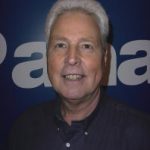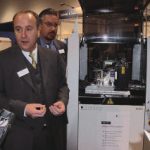IPC/SMEMA-sponsored Apex has settled in as the unchallenged show and conference event of the U.S. electronics assembly industry. If there was controversy in the beginning over who could participate and where it would be held, Apex has now resolved those squabbles. And despite the continuing gloom in the industry and the post-trauma of September 11th that especially spooks U.S. travelers, the event can be called a solid success, even if attendance figures were down by 20% (to a total of 11,000, including exhibitors staffs), and a few empty spots appeared on the expanded (by about 30%) show floor of the San Diego Convention Center.
This year, every exhibitor got the welcome mat in Southern California. „We have accommodated all the companies from the Apex 2001 waiting list,“ says IPC official LisaGriffin, „and we have space available for other newcomers as well.“ Good news, at last, for exhibitors and visitors from overseas, who must serve their U.S. business partners in time and cost efficient ways. Even better: next year, Apex will move to the still larger Anaheim Convention Center, much closer to the well-linked LA int’l airport. Most important,it will be later in the year, March 31 to April 2, 2003. And, two years later – miracles do happen – the event might even co-locate with the IPC Printed Circuits Expo, which currently carves its niche in Long Beach, California.
It would make sense, and it would be a real event, rivaling Productronica in Munich ona yearly basis,if not in scalethen certainly in scope. Obviously, it seems that the electronics manufacturing com-munity needs an annual key event to walk in common with this industry’s innovation and business cycles. In the global-ized trade scenario it’s not a big problem where such an event will take place: be it Munich in Europe, in the U.S. San Diego or Anaheim or in Asia Singapore, for example. What really makes the difference is the concept of the trade show, the industry backup and its timed position in the yearly run.
The hot topics of the currently finished Apex can be quickly enumerated. Besides pick and place (its original focus), it highlighted the application-driven shifts in quality-assurance strategies (accommodating AXI next to AOI). And notto be forgotten: it documented the by now endless debate over lead-free soldering (U.S. industry co-operative Nemi now settling on the alloy Sn3.9Ag0.6Cu), and the preparations for 0201 and opto-component placement. Also in focus are MEMS, packaging and underfill dispensing, the optimization of supply-chain security and workflow software, to hopefully prevent the book-ings and inventory disasters of 1999/ 2000 that have brought the industry to its knees; and the intensified move of equip-ment vendors to offer complete assembly process solutions, including design for automation, product intro, first-article verification, transferability to EMS and more.
All about co-operations
This all means partnerships and alliances to integrate third-party equipment and expert-ise – as has been exercised recently by Agilent and Siemens, Speedline and Assembleon, or in the form of direct merger, for example when Teradyne just recently took over former competitor GenRad. „I think the merger works very well,“ says Mike Smith, Manager of Strategic Technologies at Teradyne. „The culture of the two companies was very similar. So it came as a bonus that both product lines could be left virtually intact. For instance, we have brought the 1800 board tester line into the Windows environment and are taking advantage of the cost reduction achieved by this,“ he explaines. „GenRad has had great software, so now we have the design-to-manufacture tool, the optimization tool and the architecture tool.“
Also announced was the naming of Agilent by Siemens asa preferred partner for board test equipment integration in-to the Siplace as-sembly lines, and its business alliance with Corning Cable Systems to jointly develop fusion splicing equipment for fiber-optics in PCB manufacturing and assembly. Likewise, Agilent and Motorola formally announced their agreement about developing a common shopfloor information platform based on Agilent’s Intelligent Test Framework and Motorola’s Manufacturing Execution System Software.
Gloom and doom
Is the entire industry in a state of gloom and doom? Of course not. There are definite bright spots. Frank Murch of Asymtek obviously occupies oneof them: „I see the future alittle different than most people. I believe there will be a slight month-over-month increase in the first half of the year, plus an accelerating inthe second half.“ Where isthe sweet spot of the recovery? „Automotive is very strong. Mil and industrial are strong as well.“ Murch sees the upswing in the telecom and compu-ter industry, too. Underfill for CSP applications is revivingas well. „We see real capaci-ty sales, not just capability sales.“
Freshly appointed president and CEO of Siemens Dematic EAS (Siplace) Gerhard Ott who is succeeding Peter Drexel is equally bullish on the automotive segment: „In automotive electronics, we are engaged with all the major manufacturers.“ The automotive business runs much smoother, and it exhibits far fewer ups and downs than the mobile phone business. „Perhaps there are a few cars less being sold, but each single car has even more electronics in it.“ Of course, Siemens has been hit by the downturn as well. „We run significantly lower in terms of absolute sales figures,“ Ott says, „but at the same time we could noticeably grow our market share.“
Odd-form assembly, only a sidelight of the process, is a good example for this accelerating trend, where Siemens has adopted a small-footprint HiSAC 500 of PMJ. It fits one of the few remaining growth areas of the last twelve months – assembly of consumer products. Alan Duck, CEO of PMJ, says, „The operation of mounting a circuit board into a plastic shell, be it a PDA or a cell phone, is now being fully automated.“ Similar excitement abounds about odd-form at Juki, with their placement machine KE-2040. „It has dual-camera vision allowing simultaneous pick and place as well as inspection,“explains spokesperson Lauren Elliot.
The expected rise
When will the industry rise again? Can it ever return to the heady days of the years 1999/ 2000? Good question, and on everybody’s mind in this business. But, sorry, no definite answer yet. At least not at Apex. To the contrary, a deep gloom was palpable, as if the desperate holdovers of 2001 had run out of steam and money by New Year’s Eve. Still, U.S. consumers are spending for gadgets and necessities, but they get deeply discounted prices just to clear the clogged inventory pipeline. Same at the capital goods level: brand new machines, we heard, are sold „used, refurbished, preowned or remanufactured,“ not at a 50% discount, but up to huge 70%. There is still too much capacity on-stream of the latest technology, under-used. No need for quick replacements and expansions. On the other hand, the wild growth of the CEM segment over the last couple of years has turned into a flater incline – because, to say it in simplistic terms, there is not much first-rate OEM capacity left to be sourced out or unloaded to CEMs.
There is one exception: China. China is apparently on a steep ascent to world-class manufacturing (see EPPE Europe 1/2, page 6). Same in Central and Eastern Europe, but not to the same degree. These shifts in CEM activity and fab investment are taking their toll on other developing regions, such as Latin America. Another observation, supported by industry voices: the next wave of manufacturing technology will come in the years ahead – a glimpse of it already visible at the show – which will favor OEMs that have divorced themselves from their outdated fabs. They will be first when the time has come to re-invest in manufacturing capability.
So, there is the good, the bad and the ugly. While much fab capacity sits idling, there are scarcities of a few components showing up again, just as tantals or memories. If the long-awaited upturn comes, carried by broadband and fiber, wireless networking, digital video, 3G mobile phones, etc., it might be as sudden as it is surprising. And it might catch many players with their capacities pared down, unable to react and profit from the opportunities ahead.
Werner Schulz/gbw
Share:












